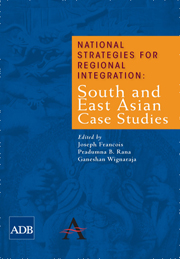3 - Pakistan
from South Asian Perspectives
Published online by Cambridge University Press: 05 March 2012
Summary
Economic Structure and External Orientation
Pakistan, like many other developing economies, is actively pursuing a policy of enhancing regional economic cooperation. Of particular interest to Pakistan are the South and East Asian economies. Pakistan is a signatory to the South Asian Free Trade Area (SAFTA), which came into force in July 2006. Pakistan developed its Strategic Vision East Asia initiative in 2003, which aims to stimulate trade and investment ties with South and East Asia. These ties are currently weak but have considerable potential for growth.
In view of the growing trend toward regionalism, it is imperative for Pakistan to solidify its economic relations especially with the South Asian and East Asian countries. The South Asian developing economies are opening up with a view to accelerating their economic growth through greater trade and investment. Against this backdrop, this country paper provides a comprehensive review of economic structure in Pakistan with particular emphasis on trade, investment, and potential for regional cooperation. The rest of this chapter reviews the economic structure and external orientation of Pakistan's economy. This paper (i) discusses Pakistan's foreign direct investment (FDI) regime and policies; (ii) discusses and analyses merchandise trade policies with emphasis on East and South Asia; (iii) highlights infrastructure and trade administration issues; (iv) describes the service sector trade; and (v) concludes the discussion and spells out some policy implications.
- Type
- Chapter
- Information
- National Strategies for Regional IntegrationSouth and East Asian Case Studies, pp. 97 - 136Publisher: Anthem PressPrint publication year: 2009



